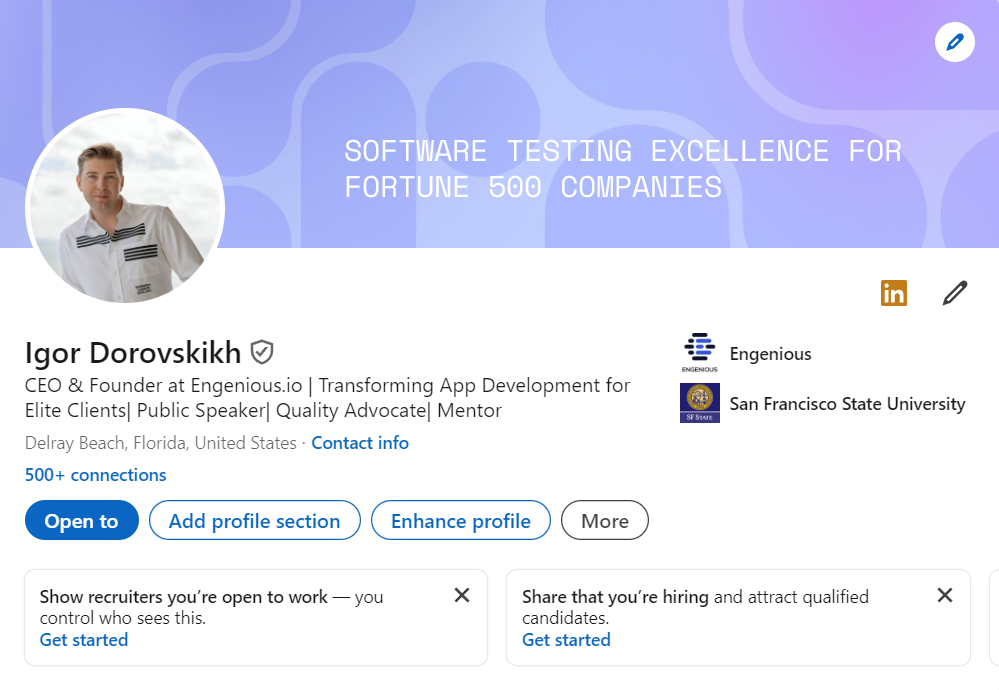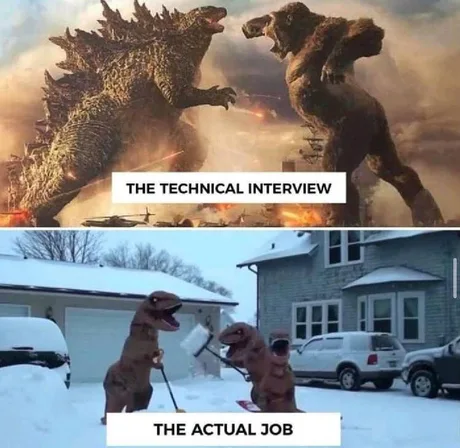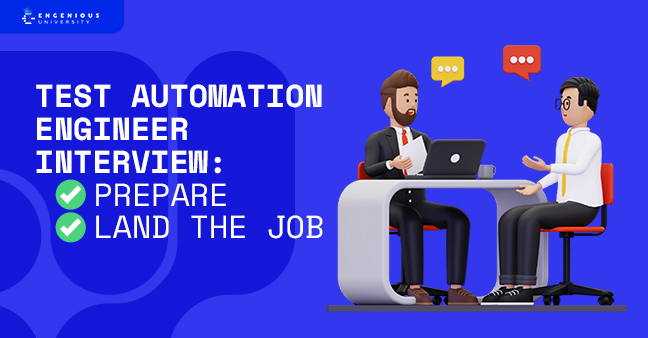The journey from a manual QA tester to a high-paid test automation engineer is marked by one pivotal (and stressful) moment: the interview.
To succeed, you need tech skills and a strategic approach to the interview process itself. It sounds like a lot. But don’t worry!
In this post, I’ll draw on the wisdom I’ve gained specializing in software development engineering in test (SDET), working with brands like Tinder, Barnes & Noble, and Expedia, and founding Engenious.
The whole 15 years’ worth.
I’ve been there, done that, and succeeded—many times over. And I’m happy to share. So grab a cup of coffee, and let’s get to it!
Branding Yourself
The test automation engineering space is competitive, so you’ve got to break through the noise. Standing out to potential employers starts long before the interview—with your personal brand.
In almost every industry today, your resume and LinkedIn profile are the basis of your brand, and they’re pivotal tools in making a good first impression.
Both resources should do things:
- showcase your experiences and
- tell a compelling story of your career
Following are some simple ways to do just that.
Tend to Your LinkedIn Profile

- Professional Headshot: A clear, professional photo where you appear approachable and confident sets the right tone.
- Compelling Headline: Instead of just your job title, include specialties or key skills. For example, “Test Automation Engineer | Expert in Selenium & Cypress | Building Robust Test Frameworks.”
- Portfolio Button: If you have an online portfolio or repository, add the portfolio button to your LinkedIn profile. It’s easy to do, plus it adds professionalism to your profile and streamlines access to your portfolio.
- Customized Summary: Your summary should narrate your professional journey, your passion for automation testing, and your career aspirations. Highlight your transition from manual testing to automation, emphasizing continuous learning.
- Detailed Experience Section: For each role, list specific projects and contributions. Use bullet points to describe what you did, the technologies you used, and the impact of your work (e.g., increased test coverage by X%, reduced regression testing time by Y hours).
- Skills & Endorsements: List key technical skills relevant to test automation engineering, such as programming languages (Java, Python), test automation tools (Selenium, TestComplete, Cypress), and CI/CD tools (Jenkins, GitLab). Invite your colleagues to endorse these skills, as well.
- Recommendations: Seek recommendations from colleagues, supervisors, or clients you’ve worked with closely. These personal testimonials can significantly boost your profile’s credibility.
- Engagement: Regularly update your profile with articles, shared insights, or projects you’re working on. Engaging with posts related to your field shows you’re active and invested in your professional community.
Ramp Up Your Resume
- Clear Format: Use a clean, professional format that highlights your experience and achievements without overwhelming the reader. Make it easy to read with clear headings and bullet points.
- Tailored Objective Statement and Skills: Briefly describe your career goals and what you bring to the table as a test automation engineer. Make it specific to the test automation jobs you’re applying for. Also, add skills relevant to the job you’re applying to. But don’t overdo it! Hiring managers can tell if you’ve cut and pasted in the job listing to trick the application tracking system (ATS). It’s not a good look.
- Include Numbers: Whenever possible, rather than just listing tasks, focus on what you accomplished. For example, “Developed a Selenium-based test automation framework that reduced the testing cycle from 2 weeks to 3 days.”
- Relevant Technical Skills: Clearly list the technical skills and tools you’re proficient in, categorizing them for readability (e.g., Programming Languages, Automation Tools, CI/CD Tools).
- Professional Development: Feature any certifications, courses, or workshops you’ve completed, especially those relevant to test automation. These courses might include things like ISTQB Advanced Level Test Automation Engineer or courses from Engenious University.
- Projects Portfolio: If possible, include a short section or a link to an online portfolio featuring projects you’ve worked on. This could be a GitHub repository or a personal website. It’s an excellent way to demonstrate your practical skills and creativity.
Want feedback on your resume? Join a mentorship session! The first 30 minutes are FREE:
Early Stage: Engaging with Recruiters and Hiring Managers
Engaging with recruiters and hiring managers is part of the process. It’s your best bet to treat these initial conversations as more than formalities.
Research the company so you can ask informed questions and express genuine interest. This preparation shows recruiters your dedication and enthusiasm for the role, setting you apart from other candidates.
Tired of reading? Watch this on YouTube:
The Crucial Pre-Interview Call
A less-known but strategic move is requesting a pre-interview call with the hiring manager. This is an efficient way to gain insight into the role’s expectations, the team culture, and the technological stack, directly from the decision-maker.
It’s also an opportunity to present yourself well, highlight your strengths, and align your experiences with the company’s needs. Looking back, I can attribute many of my career wins to these pre-interview discussions. Don’t underestimate their potential to impact the interview process in a positive way.
Mastering the Interview Process
As the world of work evolves, the interview process for test automation engineers now often includes video and in-person components.
Each format presents its own set of challenges and opportunities, requiring candidates to adapt their strategies to make a strong impression.
Tips for Nailing Video Interviews
Video interviews have become a staple, especially in the initial stages of the recruitment process. To excel in these, keep the following points in mind.
- RULE #1: Test Your Tech: Ensure your internet connection is stable, and your audio and video equipment is functioning properly. Getting caught off guard because your mic won’t work or your video keeps dropping is a recipe for stress (I know!). The Zoom test meeting is easy, fast, and worth its weight in gold. Every video conferencing platform offers pretesting, so find it and use it
- Arrive Early: The same goes for arrival time. Get set up and ready so you can jump on the meeting as soon as the interviewer arrives. This practice will also give you an additional failsafe for checking your tech.
- Professional Environment: Choose a quiet, well-lit space for the interview. Be mindful of your background—keep it neutral and free of distractions. Doing so will help you maintain your focus and will keep the interviewer focused on you and your qualifications.
- Engagement: Maintain eye contact by looking at the camera, not the screen. It takes some getting used to, but it makes a big difference by mimicking the effect of in-person engagement. Additionally, be mindful of your body language; sit up straight and use hand gestures naturally to convey enthusiasm and confidence.
- Dress Code: Dress professionally for a virtual interview, just as you would for an in-person interview. Professional dress affects the interviewer’s perception of you and can influence your mindset and performance.
In-Person Interviews: Making a Lasting Impression

When it comes to in-person interviews, the dynamics change and the physical presence adds another layer to how you are assessed. Keep these tips in mind:
- Arrival Time: Aim to arrive 10-15 minutes early. This shows punctuality and eagerness for the opportunity. Use the extra time to calm your nerves and mentally prepare.
- First Impressions: A firm handshake (or an appropriate greeting considering health guidelines) and a warm smile go a long way in setting a positive tone. Your initial interactions can set the stage for a successful interview.
- Non-Verbal Cues: Be conscious of your body language throughout the interview. Use good posture, make appropriate eye contact, and nod to show you’re actively listening and engaged in the conversation.
- Materials Preparation: Bring copies of your resume, a portfolio of your work if applicable, and a notepad for taking notes. Having your ducks in a row demonstrates organization and preparedness.
General Interview Tips for Both Formats:
- Research and Prepare: Regardless of the format, researching the company and role you’re applying for is crucial. Understand their products, culture, and the challenges they face. Tailor your responses to show how you can contribute to their success.
- Practice Common Questions: While technical skills are crucial, don’t overlook common interview questions about your experiences, strengths, weaknesses, and career aspirations. Prepare concise, impactful answers that include specific examples.
- Questions to Ask: Prepare thoughtful questions to ask at the end of the interview. Inquire about team dynamics, projects you’ll work on, or the company’s future plans. This shows your interest and initiative.
- Follow-Up: Send a thank-you email within 24 hours of the interview. Express your appreciation for the opportunity and reiterate your enthusiasm for the role. This can leave a positive, lasting impression.
The bottom line? Be prepared. I there’s a technical test component, preparedness will help open up your bandwidth for better performance. Speaking of the technical component…
Acing the Technical Test in Test Automation Engineering Interviews
The technical test is a critical component of the interview process for test automation engineers. It’s designed to assess your coding skills, understanding of automation frameworks, and problem-solving abilities.
Success in this phase requires two things:
- Technical knowledge
- A strategic approach to preparation and execution
With that in mind, here are some insights and strategies to help you excel.

Preparation Strategies
- Master Core Concepts: Confirm you have a solid grasp of programming languages relevant to test automation (e.g., Java, Python, JavaScript). Understand the syntax, common libraries, and best practices.
- Deep Dive into Automation Tools: Gain hands-on experience with key test automation tools and frameworks (Selenium, Cypress, Appium, etc.). Understand their architecture, capabilities, and limitations.
- Understand Testing Frameworks: Be familiar with testing frameworks associated with your programming language of choice (JUnit, TestNG, PyTest, Mocha, etc.). Know how to structure tests, assertions, and reporting.
- Practice Coding and Algorithm Skills: Regularly practice coding problems on platforms like LeetCode, HackerRank, or CodeSignal. Focus on data structures, algorithms, and commonly asked questions in automation interviews.
- Build a Portfolio Project: Develop a project that showcases your automation skills. For example, create a comprehensive test suite for a public API or a web application. Include diverse test cases, such as functional tests, integration tests, and end-to-end tests.

During the Technical Test
- Read the Problem Carefully: Take the time to thoroughly understand the problem statement. Ask clarifying questions if anything is unclear before you start coding.
- Plan Your Approach: Before jumping into coding, outline your approach. Think about the structure of your code, the classes and methods you’ll need, and how you’ll test your solution.
- Write Clean and Readable Code: Use meaningful variable and method names, adhere to coding standards, and comment your code where necessary. Clean, readable code is as important as a working solution.
- Test Your Code: Write unit tests for your solution to demonstrate your testing mindset. This will show your solution-focused approach and ensure your code is robust and error-free.
- Discuss Your Thought Process: While coding, articulate your thought process. Discuss the trade-offs you’re considering and why you’re choosing a particular approach. This communicates your problem-solving strategy to the interviewer.
Watch the class on preparing for coding interviews and creating algorithms:
Post-Test Discussion
- Be Ready to Explain Your Solution: Be prepared to walk through your code, and explain your logic and the choices you made. Be open to feedback and ready to discuss alternative solutions or improvements.
- Reflect on Optimization: If there are ways to optimize your solution, discuss these as well. Demonstrating this level of think-through and humility shows your teachability and proves your drive for excellence and efficiency.
Continuous Learning
- Seek Feedback: After the interview, reflect on the technical test. If the interview team offers feedback, use it constructively to identify areas for improvement.
- Stay Updated: The field of test automation is ever-evolving. Stay up-to-date with new tools, frameworks, and best practices. Continuous learning is key to staying competitive in the tech industry.
I’ll say it again: The technical test is not just about finding the right answer. It’s also about showcasing your problem-solving skills, your coding standards, and your communication abilities.
Negotiating Your Way to Success

With the recent movement toward pay transparency, many companies openly publish the salary range for a role in the listing, making things a whole lot easier.
Still, many companies don’t, and there’s a good chance you’ll be required to negotiate salary eventually—if not from scratch, at least within the listed range.
Salary negotiation is an integral part of the interview process that can’t be overlooked. To put your best foot forward, do your research before you interview, and know your worth.
It should be easy. Most of the big job posting sites have comprehensive calculators you can use to drill down by role, location, years of experience, and even whether the role is remote, hybrid, or on-site.
Most importantly, I urge you not to sell yourself short. Your skills are hard-earned and in demand. Do research and use wisdom and critical thinking, then ask for a fair wage that meets your needs.
The Engenious Path Forward
For those aspiring to transition into test automation engineering—especially if you’ve been at it and haven’t found a job—this journey might seem daunting.
It could be that you just need that nudge in your skillset to get you over the hump. If that’s the case, our Advanced iOS Test Automation with XCUITest course could be exactly what you need.
The course is designed to give you the additional education you need to get the job and excel in the role.
The Takeaway
At Engenious University, we recognize the challenges of manual QA testers eager to advance their careers. That’s why we offer free resources like this blog you’re reading now.
If you’ve still got questions, you can even sign up for a free 30-minute mentoring session with me (it’s really free!).
From preparing an impactful resume to engaging in meaningful discussions with hiring managers and skillfully navigating interviews, each step in the process is a building block toward success.
And when you’re facing a need for further education or skill enhancement, Engenious University stands ready to support ambitious professionals in their quest to land their dream test automation job. Embrace the journey with resilience, preparation, and the optimism that the right opportunity is just around the corner.
